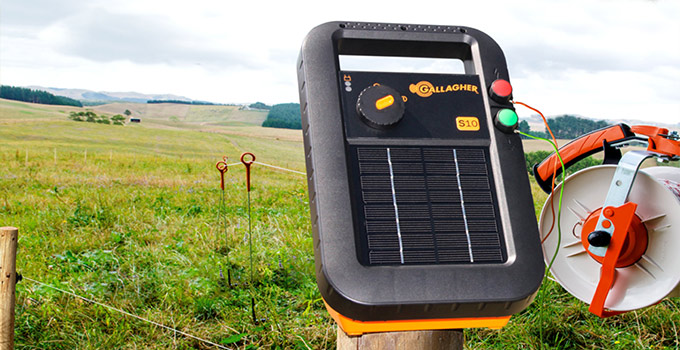When grid power is not available, solar-powered electric fencing is a dependable solution for many applications. From summer pasture management to winter swath or corn grazing to animal exclusion management, the Co-op Equip Team can help design a system to fit the application.
“There are multiple options from self-contained, all-in-one solar panels and batteries to bigger systems with separate solar panels and batteries,” said John Davis of South Country Co-op in Broxburn, Alta.
“It all depends on what you are using it for and how much energy is necessary for a remote location set up.”
Sizing the system
An all-in-one system that integrates a solar panel and rechargeable battery is one of the most common solutions for electric fencing. The sun charges the system during the day and the six or12-volt battery powers the system.
The size of the system depends on the type of animal that is being contained or the type of wildlife being controlled. Sheep, pigs, horses and goats will require a smaller system than one that is meant to keep cows in – or bears and elk out.
A key specification is the stored energy, measured in joules. A fence energizer must have enough power to drive charge down the fence line and still have enough energy to shock the animal with pulses of electricity.
“More joules are usually better depending on the animal and the area needing to be fenced. It takes a lot more energy to keep a bear or coyote out than a cow in,” Davis said.
Large systems with stand alone batteries and solar panels are used more often in remote locations where increased battery storage is required. This ensures there is power during longer stretches of cloudy days when the system can’t be checked regularly.

Reliability concerns
Customers often ask how dependable the systems are when the sun doesn’t shine. Davis said most systems provide three to four days of operation in the summer, but the entire fence needs to be in good condition.
“Eighty per cent of the performance or lack of performance will depend on things like the quality of wire used, the proper grounding and how well the fence is maintained,” said Davis. “And use a good-quality ground rod; don’t use a rusty old piece of rebar. That’s usually the majority of the problems.”
Winter can also be a challenge as cold temperatures can be hard on batteries. When the sun doesn’t shine, batteries are drained more quickly, but this limitation can be overcome by increasing the solar panel size or charging capacity. Swapping out batteries with freshly charged ones from the farmyard is another option.
Many of the systems also have integrated diagnostics that include battery status indicator, voltage output and meter operation tests. Some of the large systems are now incorporating Bluetooth technology for monitoring conditions over a phone or tablet.
Like many pieces of equipment, longevity depends on how well the system is maintained.
“The solar panel is just charging the battery,” Davis said. “With the right-sized system and a well-maintained fence, I’ve seen some systems last up to 15 years.”

